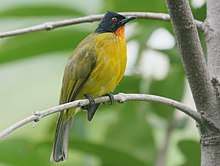Ruby-throated bulbul
The ruby-throated bulbul (Rubigula dispar), or yellow bulbul, is a member of the bulbul family of passerine birds.[1][2] It is found on Sumatra, Java, and Bali.
| Ruby-throated bulbul | |
|---|---|
 | |
| Miami Metrozoo, Florida | |
| Scientific classification | |
| Kingdom: | Animalia |
| Phylum: | Chordata |
| Class: | Aves |
| Order: | Passeriformes |
| Family: | Pycnonotidae |
| Genus: | Rubigula |
| Species: | R. dispar |
| Binomial name | |
| Rubigula dispar (Horsfield, 1821) | |
| Synonyms | |
| |
Taxonomy and systematics
The ruby-throated bulbul was originally described in the genus Turdus and later moved to genus Pycnonotus. Pycnonotus was found to be polyphyletic in recent molecular phylogenetic studies and five bulbul species, including the ruby-throated bulbul, moved to Rubigula.[2][3] Until 2008, the ruby-throated bulbul was considered as conspecific with the black-capped, black-crested, flame-throated and Bornean bulbuls. Some authorities have considered the ruby-throated bulbul to be a subspecies of the black-capped bulbul.[4]
Description
It is virtually crestless, has a deep red throat and reddish eyes.
Distribution and habitat
This is a bird of forest and dense scrub.
Behaviour and ecology
It builds its nest in a bush; two to four eggs is a typical clutch. The ruby-throated bulbul feeds on fruit and insects.
References
| Wikimedia Commons has media related to Pycnonotus dispar. |
- BirdLife International. (2016). "Rubigula dispar (formerly as: Pycnonotus dispar)". IUCN Red List of Threatened Species. 2016: e.T103827052A104338311. doi:10.2305/IUCN.UK.2016-3.RLTS.T103827052A104338311.en. Retrieved 9 August 2020.
- Gill, F.; Donsker, D.; Rasmussen, P. (eds.). "Family Pycnonotidae". IOC World Bird List. Version 10.2. International Ornithological Congress. Retrieved 8 August 2020.
- Shakya, Subir B.; Sheldon, Frederick H. (2017). "The phylogeny of the world's bulbuls (Pycnonotidae) inferred using a supermatrix approach". Ibis. 159 (3): 498–509. doi:10.1111/ibi.12464. ISSN 0019-1019.
- "Species Version 1 IOC World Bird List". www.worldbirdnames.org. Retrieved 11 March 2017.
- Rasmussen, P.C., and J.C. Anderton. (2005). Birds of South Asia. The Ripley Guide. Volume 2: Attributes and Status. Smithsonian Institution and Lynx Edicions, Washington D.C. and Barcelona
